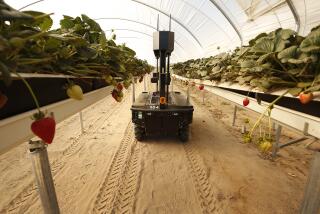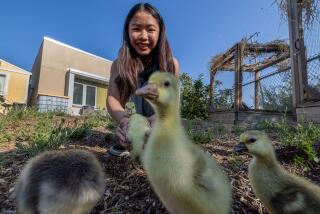HIGH LIFE: A WEEKLY FORUM FO HIGH SCHOOL STUDENTS : Students Find Niche at Farm
The usual clatter and chatter of animals is hushed by the rhythmic beat of the rain. The musty scent of dank wood and grass lingers in the air.
A few trees near the trailer stand with humility, their once-golden leaves stripped off by the wind.
Itâs still winter on the farm.
Above, on the main campus of Sunny Hills High School in Fullerton, an occasional moo or baa or even an oink is barely audible.
On a clear day, while walking the dusty trail that winds down the hill from the campus, one sees animals napping in the shade of trees while a student drives a tractor around the field.
The initials FFA (Future Farmers of America), carved in concrete, welcome all to the farm.
âItâs a whole separate world down here,â junior Michaela Hammett said. âThereâs a whole different group of people who do crazy things.â
Some have misconceptions about the farm. They see it simply as a place full of manure and filth, and its student inhabitants as farmers--unsophisticated people clad in soiled overalls who milk cows, labor in fields or rock in chairs while chewing on hay.
Hammett, who has been enrolled in agriculture classes since her freshman year, has faced such prejudices.
âLast year, my friend and I always used to talk about her pig, and people would hear us and go, âWhat!â â she said.
The FFA sweat shirt Hammett wears has also drawn its share of comments, to which she replies, âYou go down there and try to take care of those animals!â
But agriculture students donât have to want to be farmers, they just have to have ambition and a desire to learn about animals, plants and the environment.
âThe people enrolled in these agriculture classes might become veterinarians, forest rangers, even microbiologists,â said Cindy Tessler, a junior.
James Bailey, the schoolâs agriculture teacher, describes the opportunity presented to students as a âchance to develop goals and become a part of society.â
Bailey said that agriculture classes âattract various types of people with different ranges of ability because (the classes) are out of the ordinary, involve the outdoors and are excellent for future career references.â
Introductory Agriculture teaches the techniques of tending animals, while Advanced Agriculture teaches about the animalsâ internal structure and behavior.
Veterinary Science, the most popular of the classes, involves studying diseases and treating the animals. About 30 students are enrolled in this class.
Hammett herself can be found at the farm during fourth and sixth periods and after school until about 4:30 p.m. She spends her time there cleaning the classroom, feeding her animals, selling feed or just hanging out.
âIâm like a paid farmhand,â said Hammett, who receives wages for the extra chores she performs.
Hammett said she has found her own little niche in the farmâs openness.
On the grounds, students mill around the rows of large, wooden feed boxes, which open like chests and serve as huge lockers for the agriculture students who congregate there after doing their chores.
When opened, some of these boxes reveal cages of rats, mice or rabbits, or just about anything their owners want to store.
Students casually sit on the edges of the boxes, dangling their legs against the sides as they talk and relax.
So socially, as well as academically, agriculture classes have helped Hammett.
âWhen I was in junior high school, I was really shy and barely talked to anybody,â she said. âThrough ag, Iâve learned to work with people whether I like them or not, and the class has also helped me to be responsible. Thereâs a lot of manual work involved too.
âPeople complain about the smell of the farm,â Hammett added, âbut after shoveling pig waste, I just tell them, âHey, honey, you get used to it.â â
After a hectic sophomore year, when she tended to 50 chickens, 12 rabbits, 60 rats, two calves and a pig, Hammett has lessened her workload this year. She is presently concentrating her efforts on one rabbit, a few rats and a pig.
âThis year, I didnât want to tire myself out,â Hammett said.
Veteran agriculture students prefer to raise different types of animals each year.
Velvet Finckbone, a senior, owns seven rabbits. Last year, she owned a lamb and a steer.
âI like to take care of my animals as if Iâm taking care of myself,â Finckbone said.
The animals, which are paid for by the students, are also managed on the studentsâ time--before or after school and on weekends.
If a student fails to take proper care of an animal or is abusive to it, the animal is taken away and locked in a pen where another student is assigned to its care.
Though the hours put into an agriculture class may seem fruitless to some, Hammett said the effort can be rewarded by some very touching moments.
âOne time, we were down here until 3 a.m. to see the birth of a pig,â she said. âAnd another time I saw a baby lamb right after its birth.â
Sharing so many hours and so much effort with the animals often creates a bond that is hard to break.
âDuring the time you have your animals, youâre learning about them and they become like pets,â Hammett said.
She described how she raised a pig last year and how she had to watch her âlittle friendâ go up onto the truck that carted the animals away to the butcher.
âI saw him and thought, âOK, so now heâs off to Farmer Johnâs,â said Hammett with remorse.
Every summer, the agriculture students take part in the Orange County Fair, where their animals are judged.
Hammett remembered a sight that particularly touched her at last yearâs fair.
âIt was the last day, and I saw a girl who had to give up her little lamb. She was hugging it in the corner and crying.â
A natural attachment develops between animal and man, Hammett said, adding that her love of animals was the reason she enrolled in agriculture classes.
âIâve always wanted to be a vet and have my own business,â she said. âI want to be in some field where Iâm caring for animals.â
More to Read
Sign up for Essential California
The most important California stories and recommendations in your inbox every morning.
You may occasionally receive promotional content from the Los Angeles Times.










